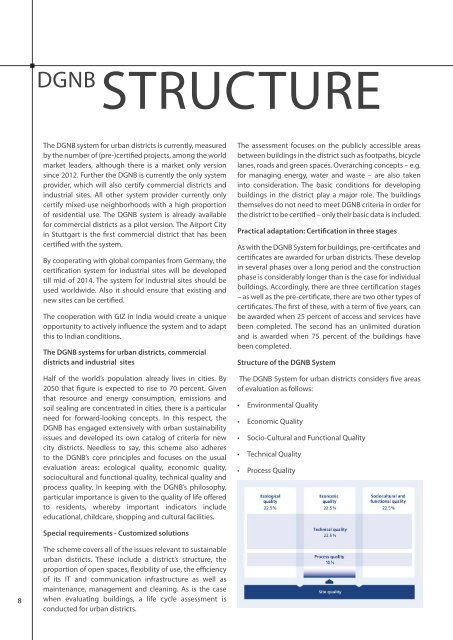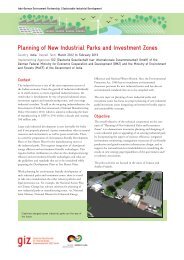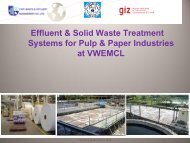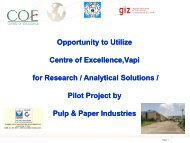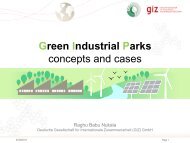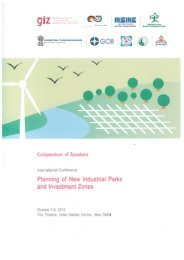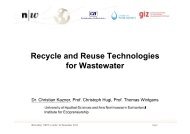Brief Profile of DGNB Germany - IGEP.in
Brief Profile of DGNB Germany - IGEP.in
Brief Profile of DGNB Germany - IGEP.in
Create successful ePaper yourself
Turn your PDF publications into a flip-book with our unique Google optimized e-Paper software.
<strong>DGNB</strong><br />
STRUCTURE<br />
The <strong>DGNB</strong> system for urban districts is currently, measured<br />
by the number <strong>of</strong> (pre-)certified projects, among the world<br />
market leaders, although there is a market only version<br />
s<strong>in</strong>ce 2012. Further the <strong>DGNB</strong> is currently the only system<br />
provider, which will also certify commercial districts and<br />
<strong>in</strong>dustrial sites. All other system provider currently only<br />
certify mixed-use neighborhoods with a high proportion<br />
<strong>of</strong> residential use. The <strong>DGNB</strong> system is already available<br />
for commercial districts as a pilot version. The Airport City<br />
<strong>in</strong> Stuttgart is the first commercial district that has been<br />
certified with the system.<br />
By cooperat<strong>in</strong>g with global companies from <strong>Germany</strong>, the<br />
certification system for <strong>in</strong>dustrial sites will be developed<br />
till mid <strong>of</strong> 2014. The system for <strong>in</strong>dustrial sites should be<br />
used worldwide. Also it should ensure that exist<strong>in</strong>g and<br />
new sites can be certified.<br />
The cooperation with GIZ <strong>in</strong> India would create a unique<br />
opportunity to actively <strong>in</strong>fluence the system and to adapt<br />
this to Indian conditions.<br />
The <strong>DGNB</strong> systems for urban districts, commercial<br />
districts and <strong>in</strong>dustrial sites<br />
Half <strong>of</strong> the world’s population already lives <strong>in</strong> cities. By<br />
2050 that figure is expected to rise to 70 percent. Given<br />
that resource and energy consumption, emissions and<br />
soil seal<strong>in</strong>g are concentrated <strong>in</strong> cities, there is a particular<br />
need for forward-look<strong>in</strong>g concepts. In this respect, the<br />
<strong>DGNB</strong> has engaged extensively with urban susta<strong>in</strong>ability<br />
issues and developed its own catalog <strong>of</strong> criteria for new<br />
city districts. Needless to say, this scheme also adheres<br />
to the <strong>DGNB</strong>’s core pr<strong>in</strong>ciples and focuses on the usual<br />
evaluation areas: ecological quality, economic quality,<br />
sociocultural and functional quality, technical quality and<br />
process quality. In keep<strong>in</strong>g with the <strong>DGNB</strong>’s philosophy,<br />
particular importance is given to the quality <strong>of</strong> life <strong>of</strong>fered<br />
to residents, whereby important <strong>in</strong>dicators <strong>in</strong>clude<br />
educational, childcare, shopp<strong>in</strong>g and cultural facilities.<br />
The assessment focuses on the publicly accessible areas<br />
between build<strong>in</strong>gs <strong>in</strong> the district such as footpaths, bicycle<br />
lanes, roads and green spaces. Overarch<strong>in</strong>g concepts – e.g.<br />
for manag<strong>in</strong>g energy, water and waste – are also taken<br />
<strong>in</strong>to consideration. The basic conditions for develop<strong>in</strong>g<br />
build<strong>in</strong>gs <strong>in</strong> the district play a major role. The build<strong>in</strong>gs<br />
themselves do not need to meet <strong>DGNB</strong> criteria <strong>in</strong> order for<br />
the district to be certified – only their basic data is <strong>in</strong>cluded.<br />
Practical adaptation: Certification <strong>in</strong> three stages<br />
As with the <strong>DGNB</strong> System for build<strong>in</strong>gs, pre-certificates and<br />
certificates are awarded for urban districts. These develop<br />
<strong>in</strong> several phases over a long period and the construction<br />
phase is considerably longer than is the case for <strong>in</strong>dividual<br />
build<strong>in</strong>gs. Accord<strong>in</strong>gly, there are three certification stages<br />
– as well as the pre-certificate, there are two other types <strong>of</strong><br />
certificates. The first <strong>of</strong> these, with a term <strong>of</strong> five years, can<br />
be awarded when 25 percent <strong>of</strong> access and services have<br />
been completed. The second has an unlimited duration<br />
and is awarded when 75 percent <strong>of</strong> the build<strong>in</strong>gs have<br />
been completed.<br />
Structure <strong>of</strong> the <strong>DGNB</strong> System<br />
The <strong>DGNB</strong> System for urban districts considers five areas<br />
<strong>of</strong> evaluation as follows:<br />
• Environmental Quality<br />
• Economic Quality<br />
• Socio-Cultural and Functional Quality<br />
• Technical Quality<br />
• Process Quality<br />
Special requirements - Customized solutions<br />
8<br />
The scheme covers all <strong>of</strong> the issues relevant to susta<strong>in</strong>able<br />
urban districts. These <strong>in</strong>clude a district’s structure, the<br />
proportion <strong>of</strong> open spaces, flexibility <strong>of</strong> use, the efficiency<br />
<strong>of</strong> its IT and communication <strong>in</strong>frastructure as well as<br />
ma<strong>in</strong>tenance, management and clean<strong>in</strong>g. As is the case<br />
when evaluat<strong>in</strong>g build<strong>in</strong>gs, a life cycle assessment is<br />
conducted for urban districts.


